Reviews
Albert Magnoli
USA, 1984
Credits
Review by Leo Goldsmith
Posted on 02 January 2013
Source Warner Home Video DVD
Categories Rock Follies II
I’m not a woman. I’m not a man. I am something that you’ll never understand.
—Prince, “I Would Die 4 U”
Sly, boyish, catty, monomaniacal, licentious, fey, irresistible, violent, needy, carnal, solipsistic, capricious, stubborn—these are the many colors (or should we say scents? flavors?) of Prince. In his 1984 vehicle Purple Rain, thinly veiled as a character known as “The Kid,” we are given Prince at the height of his powers, perhaps even a more perfect Prince. A rising star on the Minneapolis rock scene, whose band The Revolution performs regularly at the Uptown hot-spot First Avenue, The Kid embodies the Purple One in full flower from his very first appearance—where else but on stage—belting out “Let’s Go Crazy” in a tight white outfit and sparkly matador’s jacket. Dripping with sweat and a mixture of natural and artificial oils, emitting a startling array of pitches and timbres from his tiny body, The Kid bristles with all of the kinetic and erotic energies associated with that electric word, “life.”
When talking about any Rock Folly, or any star vehicle, it is no great stretch to say that the star is essentially “playing himself,” that the character is the actor and vice versa. But in the case of Prince and Purple Rain, this tautology is especially odd. Throughout his career, Prince has always emphatically, obsessively a protean figure, donning many stage names and personae, some of different genders (like the pitched-up Camille, just a couple of years later), some collective or impersonal (Paisley Park, “Slave”), one unpronounceably iconic. And similarly, his musical and performative styles harness an array of familiar and esoteric modes in odd combinations: the impossible moves and tyrannical professionalism of James Brown, the hide-your-daughters-mothers-girlfriends raunch of Rick James, the Jackson/Mayfield falsetto, the Jimi Hendrix guitar licks (literal and figurative), all bridled into an R&B/pop mini-genre of its own that would be easily marketable to the newly categorized (and largely white) MTV generation.
But of course, as the opening moments of Purple Rain make clear, there are others besides The Kid locked in that maelstrom of hair and eyeliner called Prince, and this seems to include virtually everyone at First Avenue in 1984. Apollonia, the fame-hungry Latina from the sticks (actually, Santa Monica); Morris Day, the horny, clownish, possibly coked-up leader of rival band The Time; Wendy, Lisa, Doctor Fink, Brown Mark, and Bobby Z, the members of The Revolution whose commitment to The Groove helps them to put up with The Kid’s whims, tantrums, and long bouts of egomania. Actually, to say simply that The Kid equals Prince is not enough: Prince equals Purple Rain, everyone in it and everything about it. Prince’s presence seems to infuse everyone in the film, male and female alike, subsuming each of their styles and narratives into his own persona.
This is not quite to say that the film is strictly autobiographical, although it does sell itself as such. The scenes of The Kid’s family life work hardest to put across this idea: away from the freaky, androgynous, eyeliner- and glitter-heavy club crowd at First Avenue, The Kid lives, amid innumerable Mason jars and creepy dolls, in the basement of his parents’ working-class, mixed-race, and perpetually broken home. Portrayed with the usual crazy-eyed intensity of the brilliant Clarence Williams III (see also: Tales from the Hood), his father Francis L is a shattered, drunken, abusive mass of tortured-artist clichés who slaps his wife and The Kid, and makes wild proclamations (including, memorably, “I would die for you”). Prince’s actual life story, to the extent that it’s known, seems somehow less screenplay-ready (his parents’ were in fact both black, for example), but it seems to have some ring of truth. Reportedly, the only objection of Prince’s real father - John L. - to the film was that he never owned a gun, much less shot himself in the head.
Closer to memoir, perhaps, is the subplot of rising star Apollonia Kotero, who late in production replaced real-life Prince amour Denise Matthews (a.k.a. Vanity, of Vanity 6) once she and the film’s star fell out. Contemporary profiles in Jet magazine liked to hint at a similar off-screen romantic liaison between Apollonia and Prince, but despite some heavy petting, their relationship is rarely fully convincing. (In fact, Apollonia was dating David Lee Roth at the time.) By the time Apollonia makes her own debut with Morris Day-sponsored trio Apollonia 6 at nearby club The Taste, singing the subtle ballad “Sex Shooter” in her underwear (“C’mon, kiss the gun./Guaranteed for fun”), it’s not abundantly clear why The Kid should feel betrayed. After all, while Apollonia is no one’s idea of a fully developed character and is mussed, slapped, and manhandled by The Kid and Morris alike, she is just as opportunistic and fame-hungry as all the other characters, and in this sense is yet another perfectly good image of Prince himself.
While the central conflicts within The Kid’s relationships are occasionally rather tenuous, they nonetheless offer insight into many of those aspects of Prince that we take for granted: his obsessiveness, his possessiveness, his vanity, his anti-sociability, his genius, his perversity. That said, it’s remarkable how little of this is made credible through the acting, which ranges from the artless (Apollonia) to the buffoonish (Morris and his sidekick/butler Jerome) to the melodramatic (The Kid’s parents). Prince’s own performance is all over the map: veering from a Chaplinian cheekiness to some agonized Brandoesque mooning to the sultry glares of Theda Bara. Sometimes, especially in the early part of the film, the film attempts to invest him with some indefinable “mysteriousness,” usually telegraphed by costuming and accessories (mirror sunglasses, motorcycle) or lighting (chiaroscuro, fog machine), but largely undercut by Prince’s unique presence as Prince, furry upper lip, beady eyeliner stare, and all. Fortunately, the film helps him out. Director Albert Magnoli clearly understands musicals enough to know that it’s important to let the songs do the exposition for you: after an hour or so of varyingly convincing scenes, the final acts of the film are almost entirely rendered through Prince’s songs, including montage sequences cut to “Take Me With You” and “When Doves Cry,” which aptly convey the rise and fall of The Kid and Apollonia’s relationship, but mainly the evolution of The Kid’s live act.
In fact, rather uniquely, most of the diegetic unfolding of the film is achieved through the performances, and they’re blistering performances, indeed. While none of the songs are captured live in the film, many of these recordings actually originated as recordings of live performances from an August 3, 1983 show at First Avenue, and each receives a note-(and grunt-)perfect lip-synching by Prince and the band. Purple Rain is thus not just a backstage musical, but an onstage one, too. And this makes sense: at the mic, in front of the crowd, is where Prince/The Kid belongs, feels most at home, has the most power, and is the most likeable. The anguish of “The Beautiful Ones” reveals Apollonia’s betrayal; “Computer Blue” - performed by a shirtless, sweaty, masked Prince and featuring a moment in which Wendy simulates fellatio onstage - suggests a Kid going off the rails; and “Darling Nikki,” which literally climaxes in an inferno of sex-shrieks and amp-humping, finally breaks the camel’s back of public decency. In this, the film is startlingly prophetic: this was the very song that, when heard by Tipper Gore in the presence of her fifteen-year-old daughter, prompted the formation of the Parents Music Resource Center. It was boasted the top position on their “Filthy Fifteen,” and was one of many albums that led to the use of parental advisory labels on albums featuring “explicit” material.
Of course, part of the function of Purple Rain is to stage and narrativize Prince’s own transgressive racial and sexual persona, to make his fabled desire for controversy (which Prince would soon anthemize) palatable, even saleable to a wider audience, during a period of Reagan-era retrogression at that. Thus the film’s eager, even somewhat forceful, mixing of gritty realism with sexual and celebrity fantasy. Frances L. may shoot himself in the head towards the film’s close, but all will soon be well: The Kid, after all, has a new song to perform. This song, the film’s title track—a full four minutes in its radio edit, a full eight-and-a-half in the film version—is just the deus ex machina the film needs to mend all burned bridges between himself and his father, girlfriend, and bandmates (and as dei ex machina go, it’s pretty badass). By this point, the film crosses over into pure fantasy, as eros and élan—and, why not?, a little church music—serve to heal all wounds. In the warm light of celebrity, all of The Kid’s problems are apparently solved, and all that’s need to spread the love is a final, magnificent, and triumphal gesture: to stand atop an amplifier and jizz all over the crowd with a hose-guitar.
More Rock Follies II
-
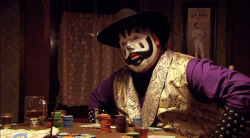
Big Money Rustlas
2010 -
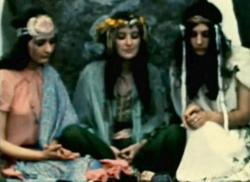
Be Glad for the Song Has No Ending
1970 -
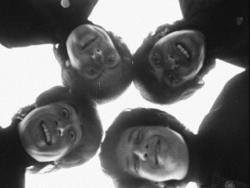
The Rutles: All You Need is Cash
1978 -
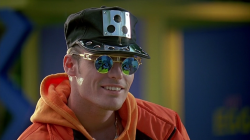
Cool As Ice
1991 -
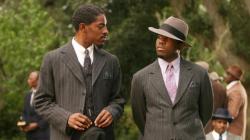
Idlewild
2006 -
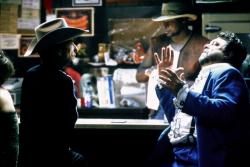
Masked and Anonymous
2002 -
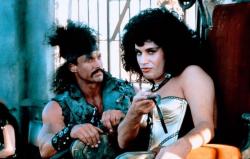
Never Too Young to Die
1986 -

Leningrad Cowboys Go America
1989 -
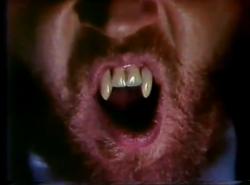
Son of Dracula
1974 -
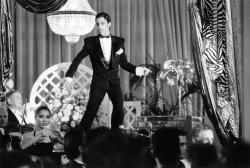
Under the Cherry Moon
1986 -
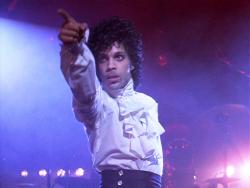
Purple Rain
1984 -
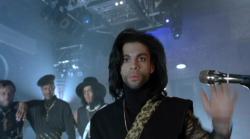
Graffiti Bridge
1990
We don’t do comments anymore, but you may contact us here or find us on Twitter or Facebook.



